CHEVROLET EXPRESS 1996 1.G Owners Manual
Manufacturer: CHEVROLET, Model Year: 1996, Model line: EXPRESS, Model: CHEVROLET EXPRESS 1996 1.GPages: 376, PDF Size: 18.83 MB
Page 191 of 376
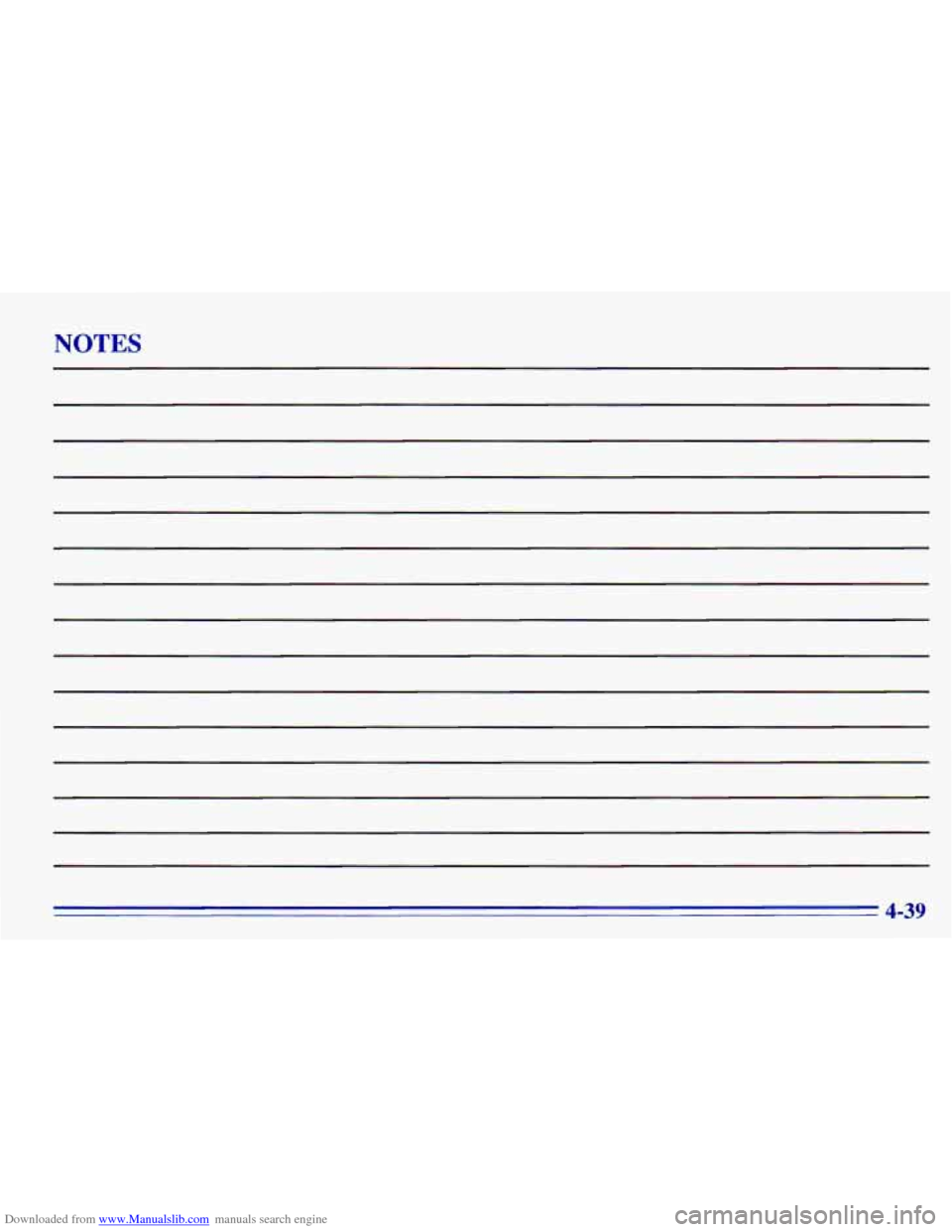
Downloaded from www.Manualslib.com manuals search engine NOTES
4-39
Page 192 of 376
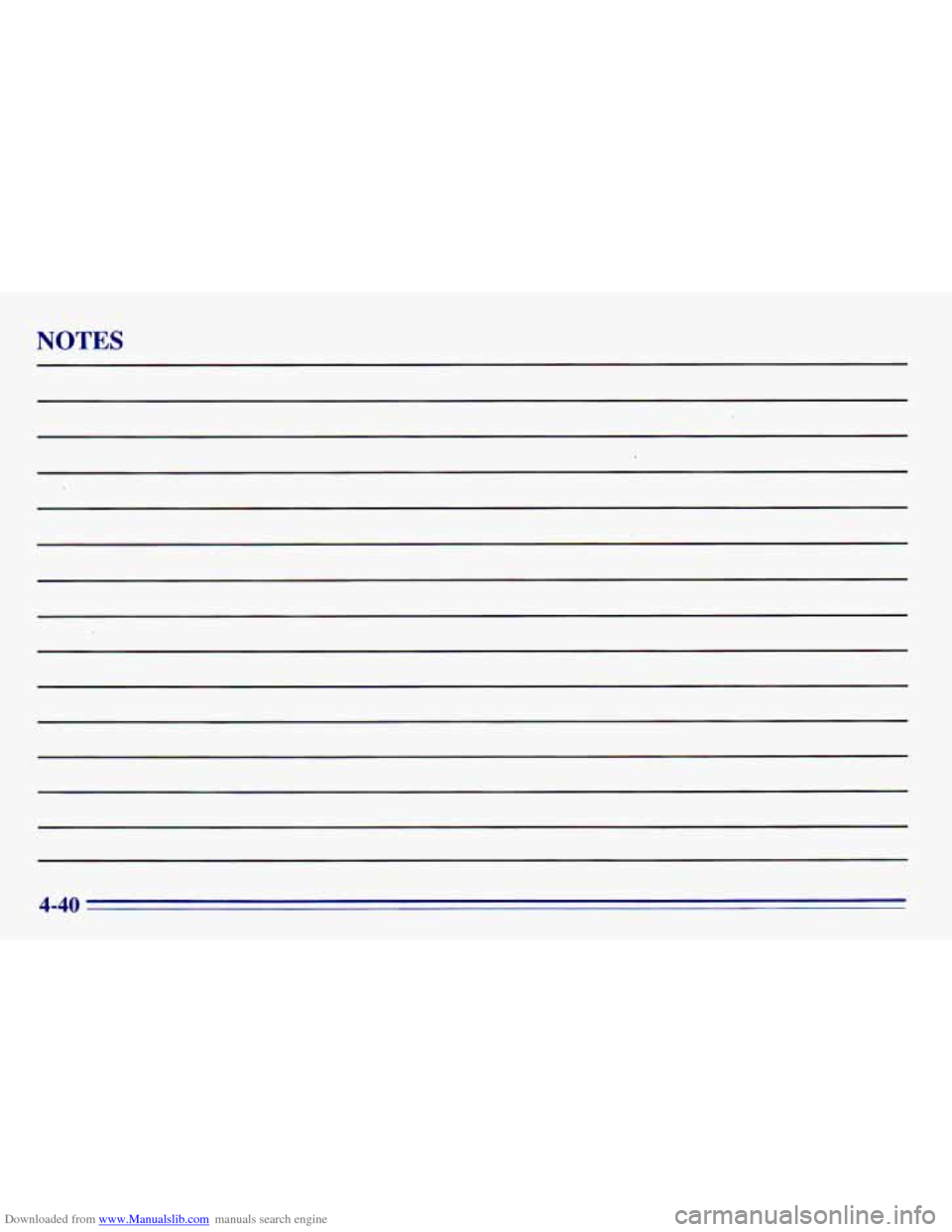
Downloaded from www.Manualslib.com manuals search engine NOTES
4-40
Page 193 of 376
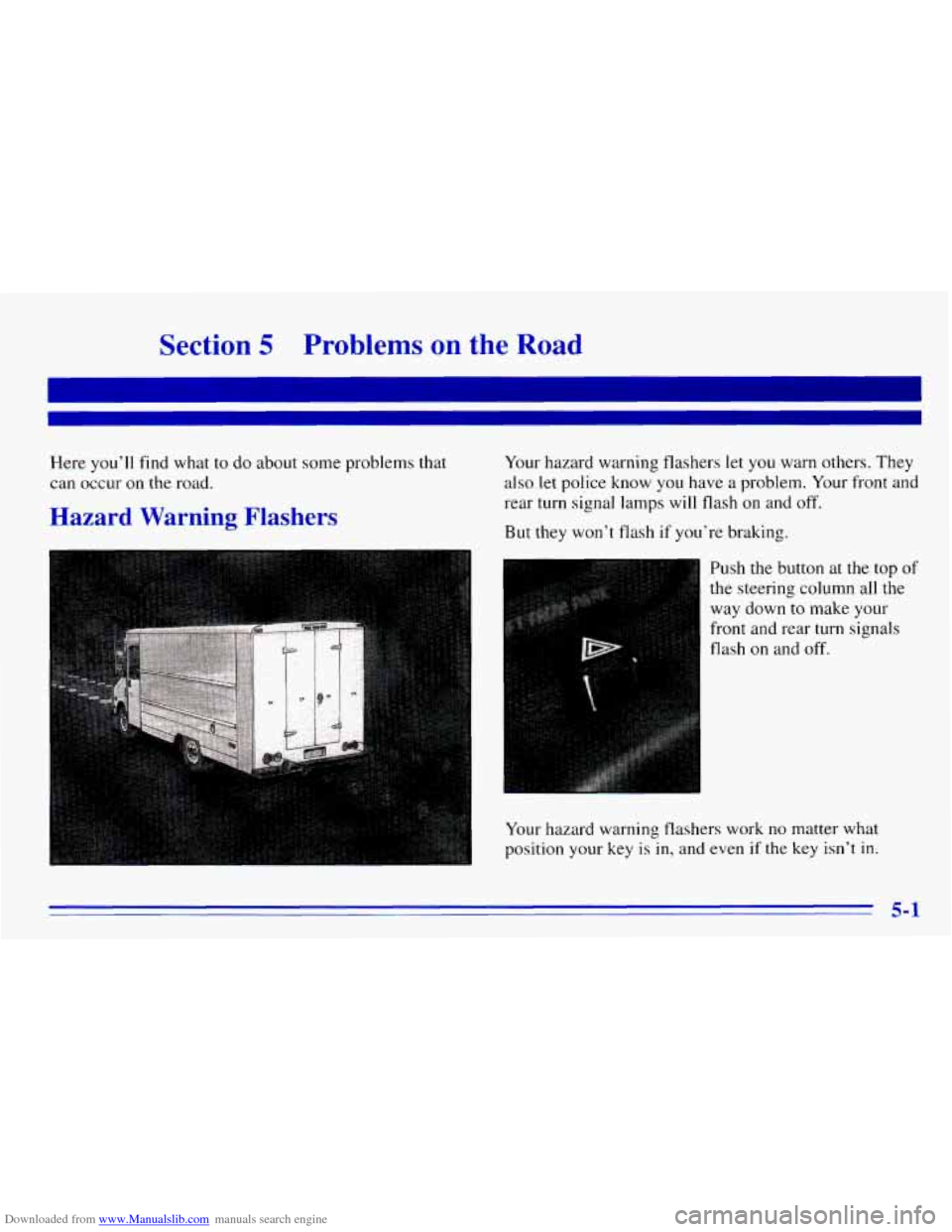
Downloaded from www.Manualslib.com manuals search engine Section 5 Problems on the Road
Here you’ll find what to do about some problems that
can occur
on the road.
Hazard Warning Flashers
Your hazard warning flashers let you warn others. They
also let police know you have a problem. Your front and
rear turn signal lamps will flash
on and off.
But they won’t flash if you’re braking.
Push the button at
the top of
the steering column all the
way
down to make your
front and rear turn signals
flash on and
off.
Your hazard warning flashers work no matter what
position your key is in, and even if the key isn’t in.
5-1
Page 194 of 376
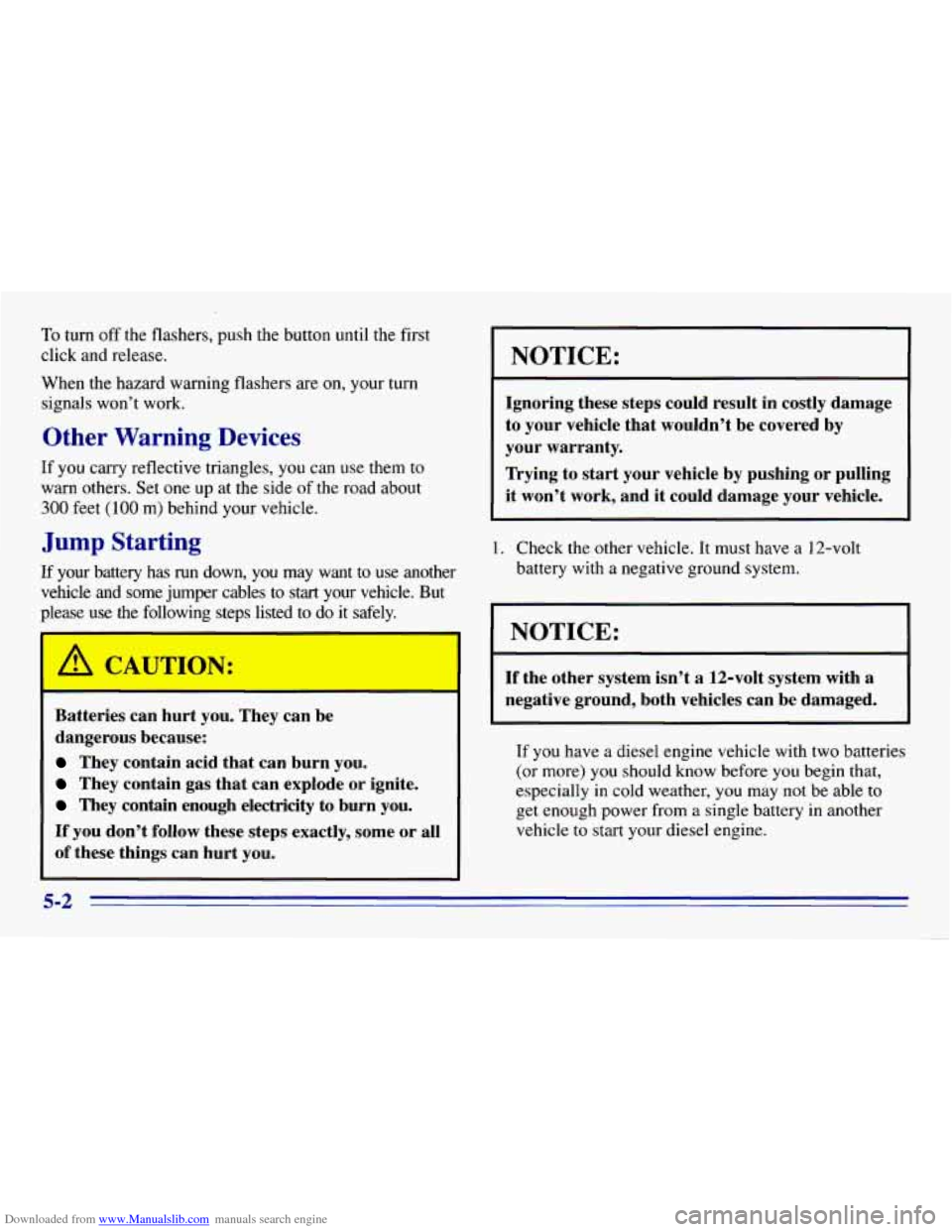
Downloaded from www.Manualslib.com manuals search engine To turn off the flashers, push the button until the first
click and release.
When the hazard warning flashers are
on, your turn
signals won’t work.
Other Warning Devices
If you carry reflective triangles, you can use them to
warn others. Set
one up at the side of the road about
300 feet (100 m) behind your vehicle.
Jump Starting
If your battery has run down, you may want to use another
Iehicle and some jumper cables to
start your vehicle. But
)lease use the following steps listed
to do it safely.
A CAUTJON:
-
Batteries can hurt you. They can be
dangerous because:
They contain acid that can burn you.
They contain gas that can explode or ignite.
They contain enough electricity to burn you.
If you don’t follow these steps exactly, some or all
of these things can hurt you.
NOTICE:
Ignoring these steps could result in costly damage
to your vehicle that wouldn’t be covered by
your warranty.
Trying to start your vehicle by pushing or pulling
it won’t work, and it could damage your vehicle.
1. Check the other vehicle. It must have a 12-volt
battery with
a negative ground system.
NOTICE:
If the other system isn’t a 12-volt system with a
negative ground, both vehicles can be damaged.
If you have a diesel engine vehicle with two batteries
(or more) you should know before you begin that,
especially in cold weather, you may not be able to
get enough power from a single battery
in another
vehicle to start your diesel engine.
5-2
Page 195 of 376
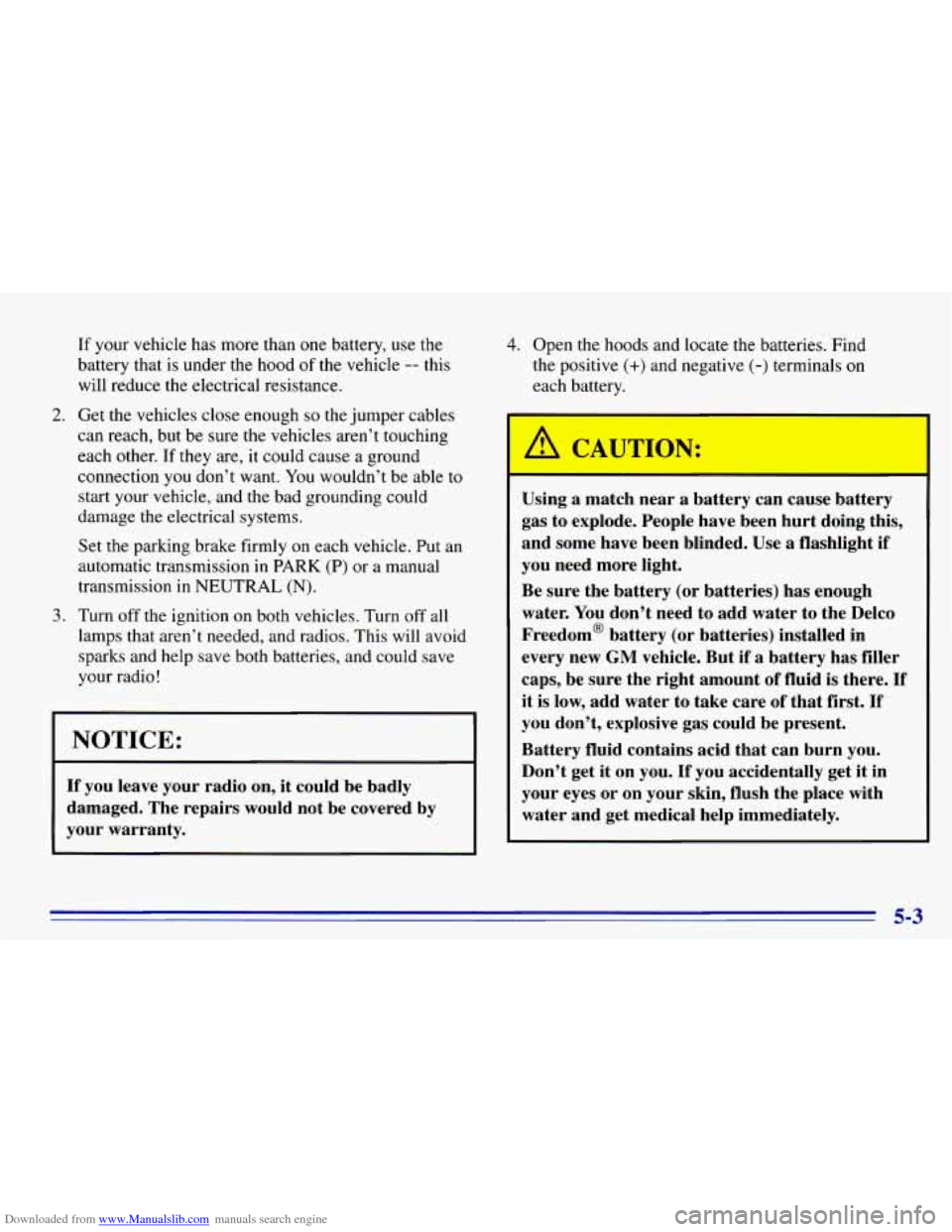
Downloaded from www.Manualslib.com manuals search engine If your vehicle has more than one battery, use the
battery that is under the hood
of the vehicle -- this
will reduce the electrical resistance.
2. Get the vehicles close enough so the jumper cables
can reach, but be sure the vehicles aren’t touching
each other.
If they are, it could cause a ground
connection you don’t want. You wouldn’t be able to
start your vehicle, and the bad grounding could
damage the electrical systems.
Set the parking brake firmly
on each vehicle. Put an
automatic transmission in
PARK (P) or a manual
transmission
in NEUTRAL (N).
3. Turn off the ignition on both vehicles. Turn off all
lamps that aren’t needed, and radios. This will avoid
sparks and help save both batteries, and could save
your radio!
NOTICE:
If you leave your radio on, it could be badly
damaged. The repairs would not be covered by
your warranty.
4. Open the hoods and locate the batteries. Find
the positive
(+) and negative (-) terminals on
each battery.
A CAUTION:
Using a match near a battery can cause battery
gas to explode. People have been hurt doing this,
and some have been blinded. Use a flashlight if
you need more light.
Be sure the battery (or batteries) has enough
water. You don’t need to add water to the Delco
Freedom@ battery (or batteries) installed in
every new
GM vehicle. But if a battery has filler
caps, be sure the right amount of fluid is there.
If
it is low, add water to take care of that first. If
you don’t, explosive gas could be present.
Battery fluid contains acid that can burn you.
Don’t get it on you.
If you accidentally get it in
your eyes or on your skin, flush the place with
water and get medical help immediately.
Page 196 of 376
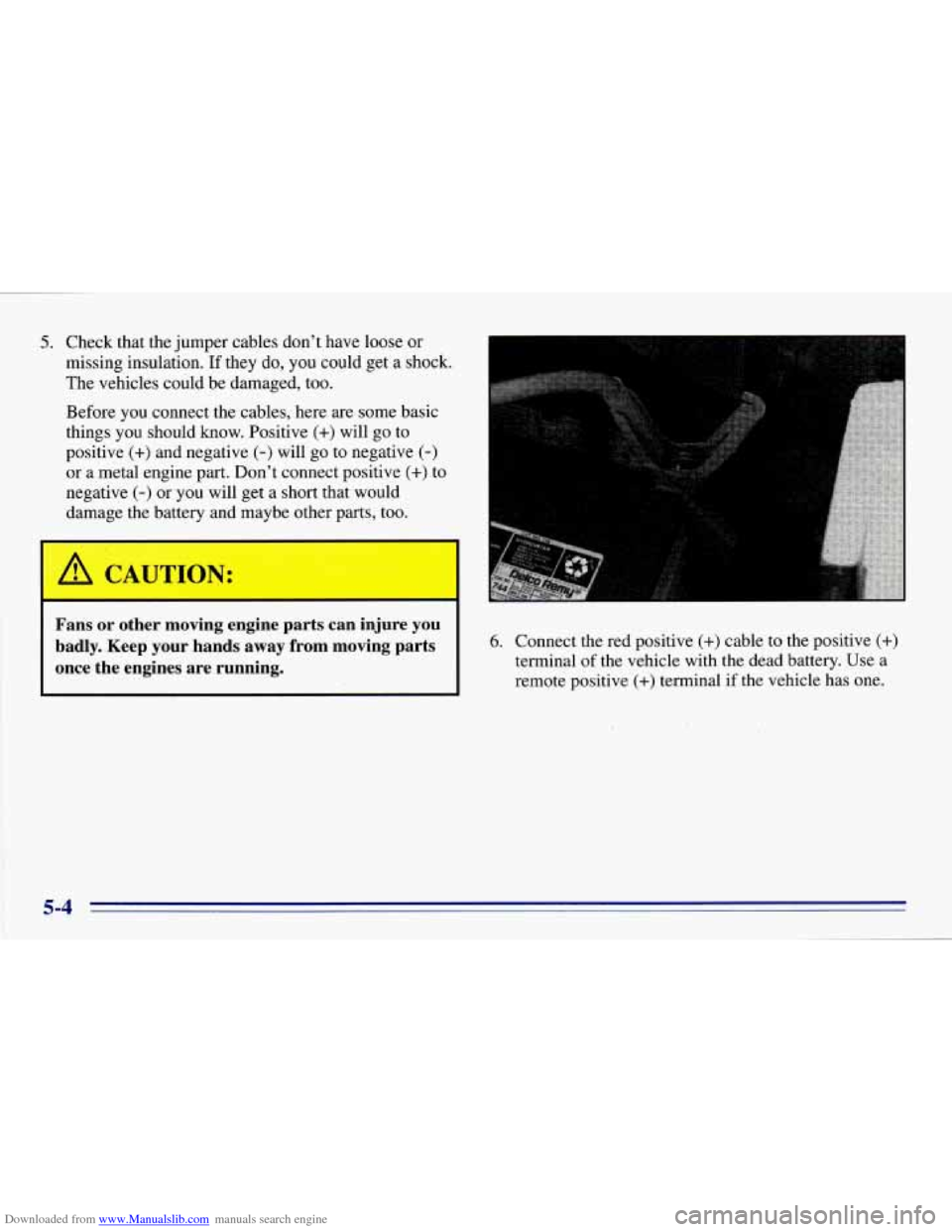
Downloaded from www.Manualslib.com manuals search engine 5. Check that the jumper cables don’t have loose or
missing insulation. If they do, you could get a shock.
The vehicles could be damaged, too.
Before you connect the cables, here are some basic
things you should know. Positive
(+) will go to
positive
(+) and negative (-) will. go to negative (-)
or a metal engine part. Don’t connect positive (+) to
negative
(-) or you will get a short that would
damage the battery and maybe other parts, too.
-
I /I CAUTION:
Fans or other moving engine parts can injure you
badly. Keep your hands away from moving parts once the engines are running.
6. Connect the red positive (+) cable to the positive (+)
terminal of the vehicle with the dead battery. Use a
remote positive
(+) terminal if the vehicle has one.
5-4
Page 197 of 376
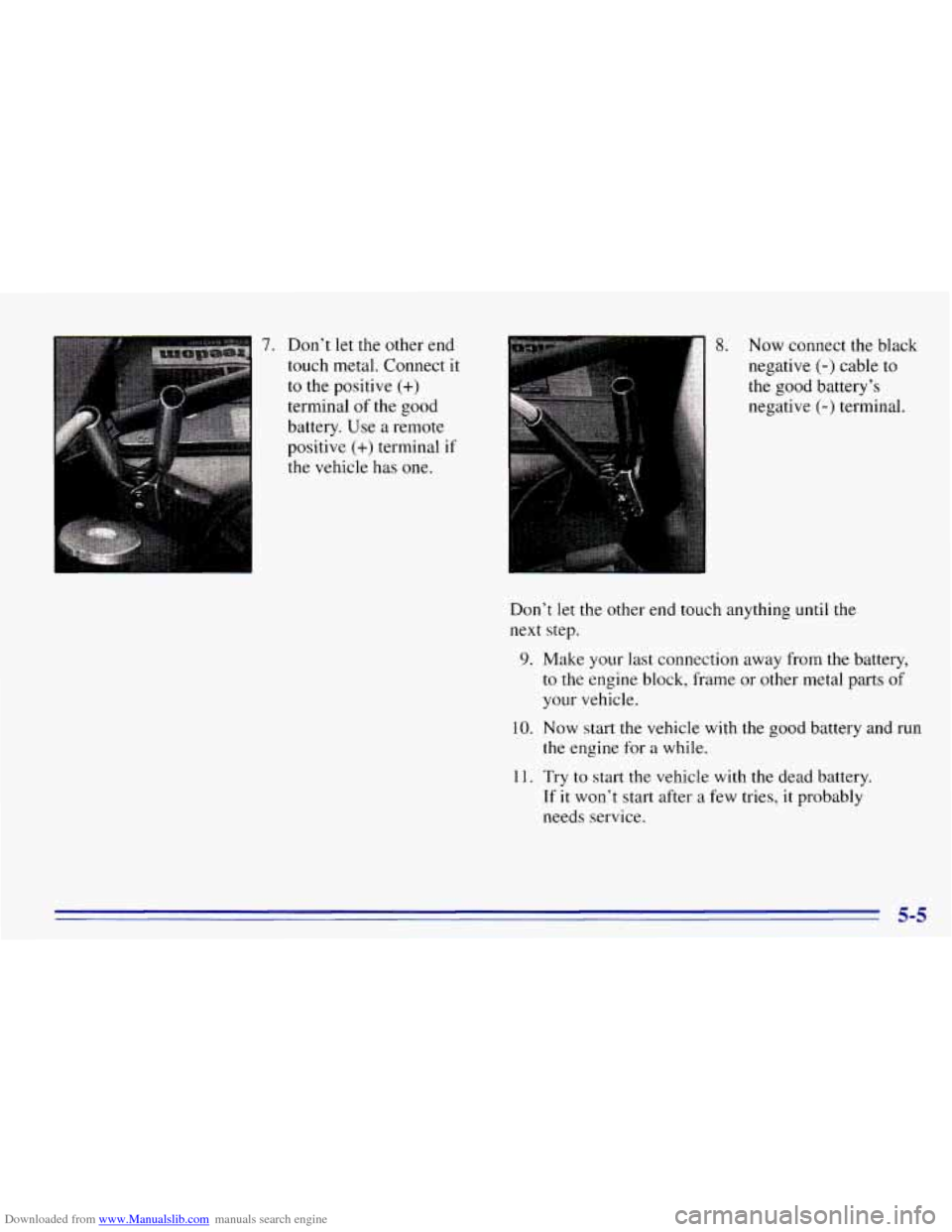
Downloaded from www.Manualslib.com manuals search engine 7. Don’t let the other end
touch metal. Connect
it
to the positive (+)
terminal of the good
battery. Use a remote
positive
(+) terminal if
the vehicle has one.
8. Now connect the black
negative
(-) cable to
the good battery’s
negative
(-) terminal.
Don’t let the other end touch anything
until the
next step.
9. Make your last connection away from the battery,
to the engine block, frame or other metal parts
of
your vehicle.
10. Now start the vehicle with the good battery and run
11. Try to start the vehicle with the dead battery.
the
engine for
a while.
If it won’t start after a few tries, it probably
needs service.
5-5
Page 198 of 376
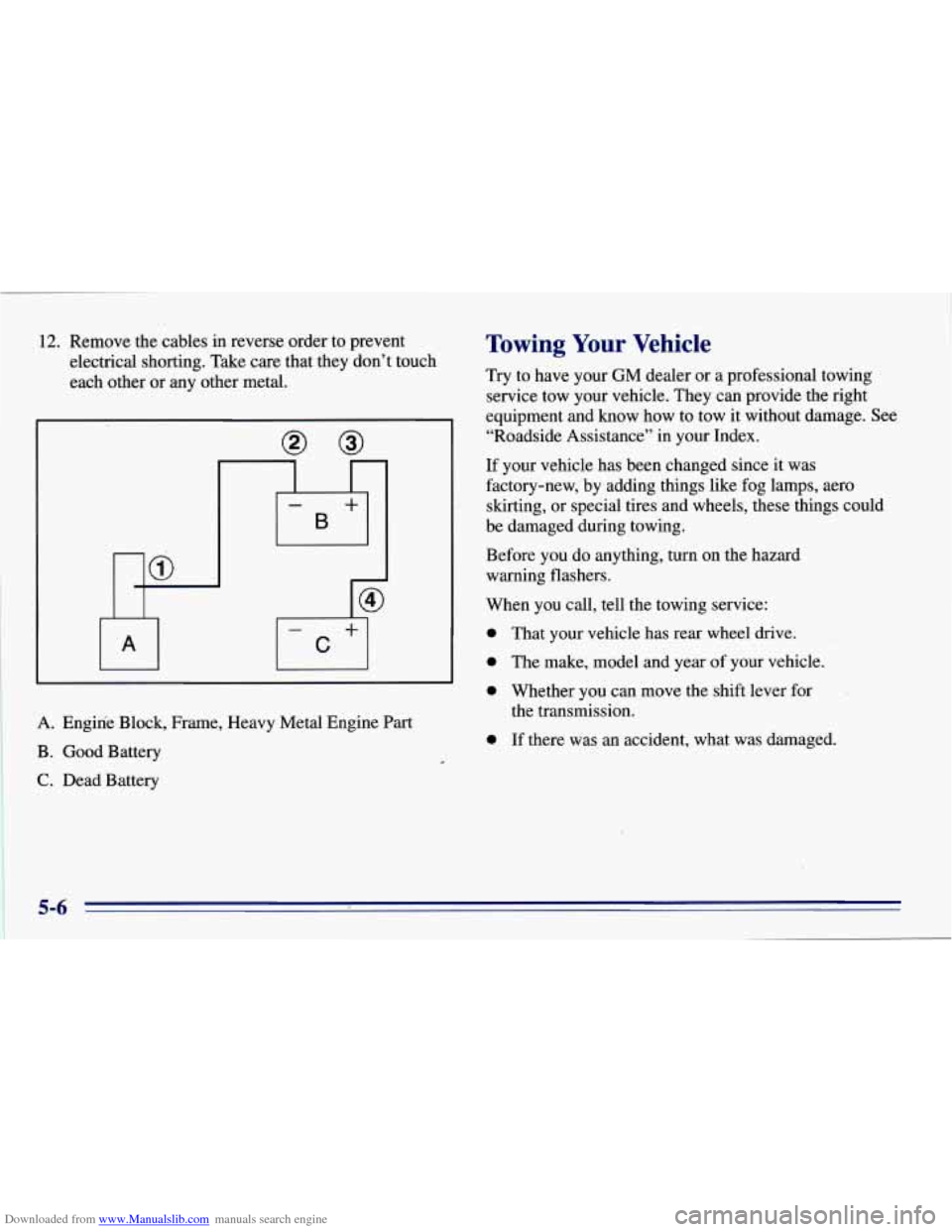
Downloaded from www.Manualslib.com manuals search engine 12. Remove the cables in reverse order to prevent
electrical shorting. Take care that they don’t touch
each other or any other metal.
I
- +
B
A. Engine Block, Frame, Heavy Metal Engine Part
B
. Good Battery
C. Dead Battery
Towing Your Vehicle
Try to have your GM dealer or a professional towing
service tow your vehicle. They can provide the right
equipment and know how to tow it without damage. See
“Roadside Assistance” in your Index.
If your vehicle has been changed since it was
factory-new, by adding things like fog lamps, aero skirting, or special tires and wheels, these things could
be damaged during towing.
Before you do anything, turn
on the hazard
warning flashers.
When you call, tell the towing service:
0 That your vehicle has rear wheel drive.
0 , The make, model and year of your vehicle.
0 Whether you can move the shift lever for
0 If there was an accident, what was damaged.
the transmission.
Page 199 of 376
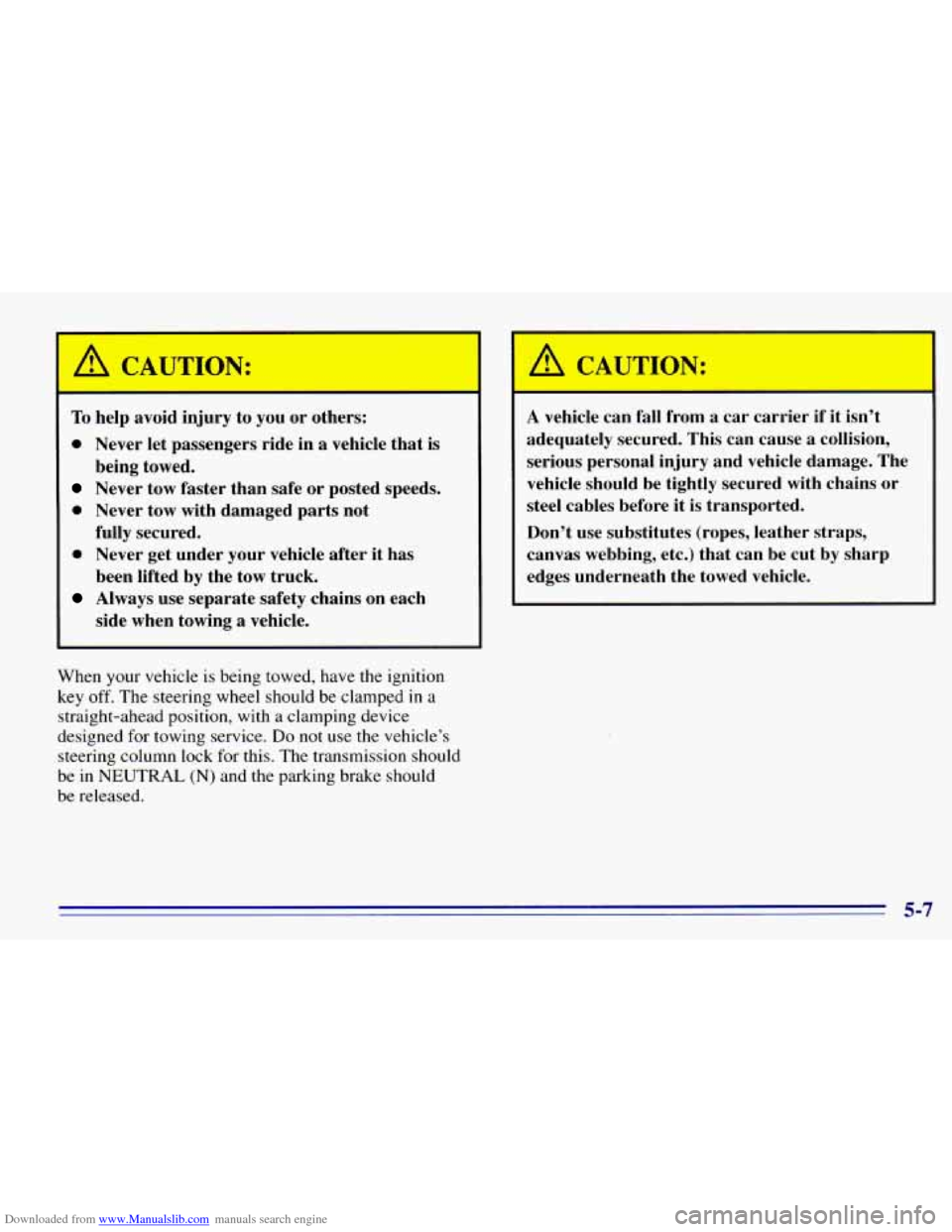
Downloaded from www.Manualslib.com manuals search engine I A CAUTION:
I I To help avoid injury to you or others:
0 Never let passengers ride in a vehicle that is
Never tow faster than safe or posted speeds.
0 Never tow with damaged parts not
0 Never get under your vehicle after it has
Always use separate safety chains on each
being
towed.
fully secured.
been lifted by the tow truck.
side when towing
a vehicle.
When your vehicle is being towed, have the ignition
key
off. The steering wheel should be clamped in a
straight-ahead position, with
a clamping device
designed for towing service.
Do not use the vehicle’s
steering column lock for this. The transmission should
be in NEUTRAL
(N) and the parking brake should
be released.
A CAUTION:
I
A vehicle can fall from a car carrier if it isn’t
adequately secured. This can cause
a collision,
serious personal injury and vehicle damage. The
vehicle should be tightly secured with chains or
steel cables before
it is transported.
Don’t use substitutes (ropes, leather straps,
canvas webbing, etc.) that can be cut by sharp
edges underneath the towed vehicle.
5-7
Page 200 of 376
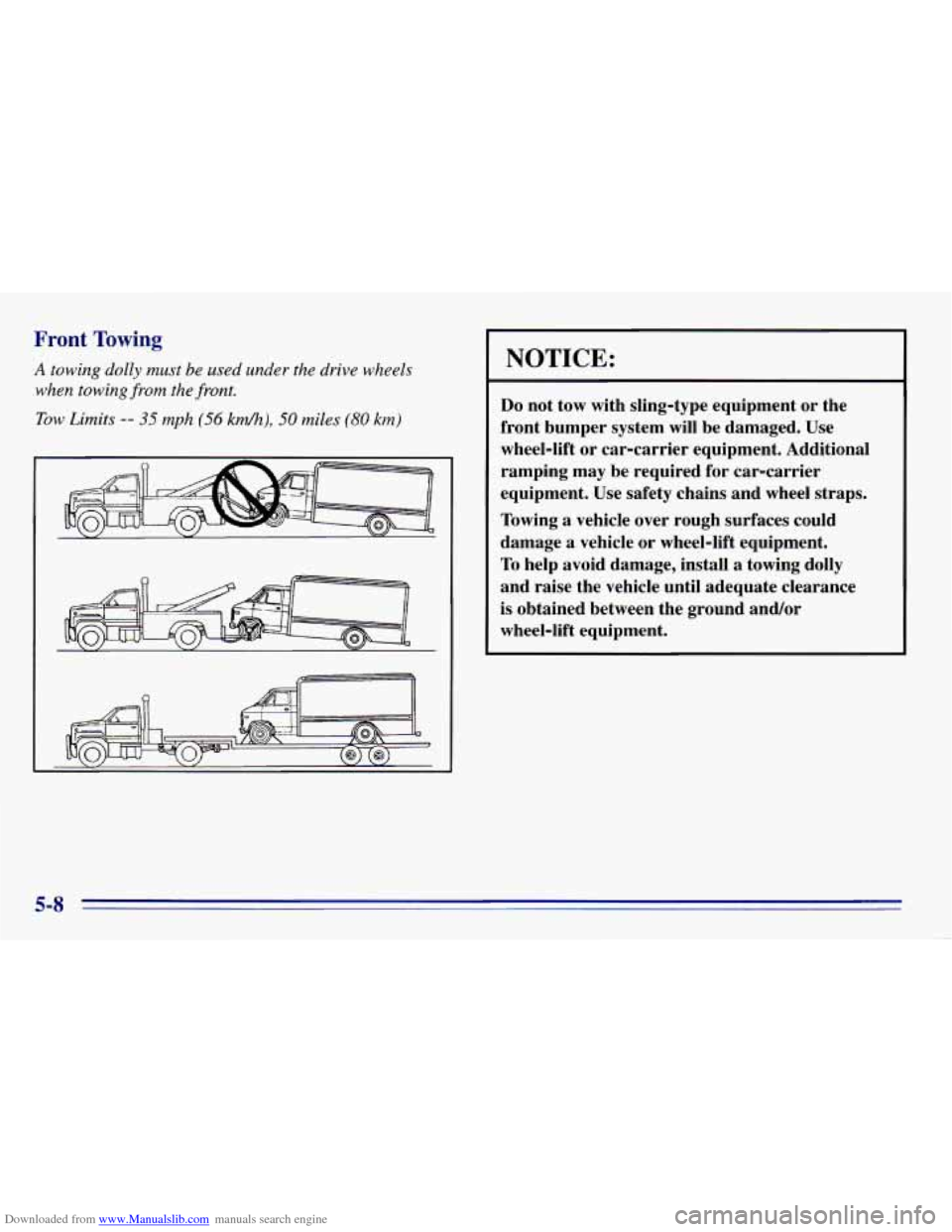
Downloaded from www.Manualslib.com manuals search engine Front Towing
A towing dolly must be used under the drive wheels
when towing from the
front.
Tow Limits -- 35 mph (56 km/h), 50 miles (80 km)
NOTICE:
Do not tow with sling-type equipment or the
front bumper system will be damaged. Use
wheel-lift or car-carrier equipment. Additional
ramping may be required for car-carrier
equipment. Use safety chains and wheel straps.
Towing a vehicle over rough surfaces could
damage
a vehicle or wheel-lift equipment.
To help avoid damage, install
a towing dolly
a,nd raise the vehicle until adequate clearance
is obtained between the ground and/or
wheel-lift equipment.